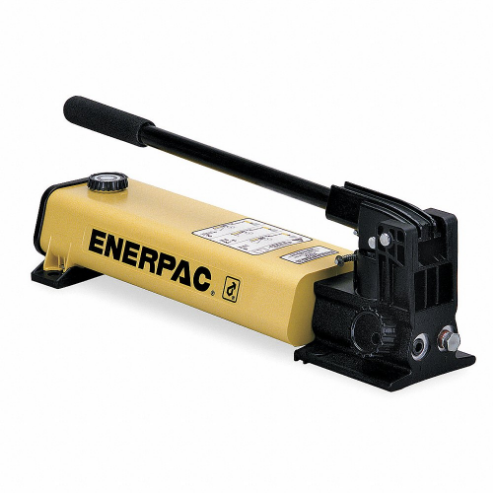Enerpac P464 hydraulic hand pump converts mechanical force into hydraulic energy in the form of fluid pressure. It is used in automotive repairs, machinery maintenance and construction projects. This pump is suitable in settings where hydraulic power is needed but access to powered hydraulic systems is limited or where portability is required.
Working Mechanism:
- When the pump's handle is actuated, it mechanically engages a piston inside the pump.
- The movement of fluid creates pressure that is utilised to operate hydraulic cylinders or power other hydraulic tools, effectively transmitting large forces through small & manageable actions.
- The pump typically includes one or more pistons that move within cylinder bores, directly responsible for driving the hydraulic fluid.
Features:
- It has a double-acting cylinder for precise control in extending and retracting applications.
- This Enerpac hydraulic pump has steel housing for durability and resistance to wear & tear.
- It has a fiberglass handle for reducing user fatigue during operation.
- This Enerpac hydraulic hand pump's handle can produce a maximum effort of 110 pounds.
Compatible Accessories:
- Enerpac GA45GC Gauge Adapter: This adapter is designed specifically for this Enerpac P-464 Ultima Series steel hydraulic hand pump to allow seamless integration of pressure gauges, enabling precise monitoring & measurement of hydraulic pressure during operation.
- Enerpac HC9206C Hose: It is a 6-foot long, 0.25-inch inner diameter hose that enables a secure and reliable connection between this hydraulic hand pump and the hydraulic components, ensuring accurate pressure measurement and monitoring.
Frequently Asked Questions:
Q. Can I use Enerpac P464 hand pump with single-acting cylinders?
A. This Enerpac hand pump is recommended for use with double-acting cylinders only.
Q. How does a hydraulic hand pump work?
A. By delivering hydraulic fluid, the hand operated hydraulic pumps convert mechanical energy into hydraulic energy under pressure, through directly applied manual effort. They use the principle of a handle delivering leverage to an internal piston.
Q. What is the difference between a single-stage and double-stage hydraulic pump?
A. Single-stage pumps rely on atmospheric pressure to move fluid, while double-stage pumps harness the combined power of hydraulic & atmospheric pressure to drive the pump.
Q. What is the pressure rating of this hydraulic pump?
A. This pump provides first-stage and second-stage pressure ratings of 200 & 10000 psi, respectively.
Q. Are there any safety features incorporated in this Enerpac P-464 Ultima Series hand pump?
A. Yes, the brand's P-464 Ultima Series hand pump is equipped with safety features, such as a pressure relief valve which prevents over-pressurisation and ensures the safe operation of the hydraulic system.
Q. What safety precautions should I take when using this Enerpac P464 hydraulic hand pump?
A.
- Always release the pressure in the hydraulic system before making any connections, disconnections or repairs.
- Ensure all connections are secure and tight to avoid leaks and potential injury.
- Use the pump within the specified pressure limits to avoid over-pressurisation, which can lead to equipment damage or failure.
- Wear appropriate personal protective equipment (PPE), such as gloves and safety glasses, when operating the pump.
Q. How to maintain this Enerpac P464 hydraulic hand pump to ensure longevity?
A.
- Regularly check and replace the hydraulic fluid to prevent contamination that can lead to increased wear and failure.
- Inspect the pump for any signs of wear or damage, particularly in the seals and valves and replace these components as necessary.
- Keep the external parts of the pump clean from dirt and debris to prevent them from entering the hydraulic system.
- Follow scheduled lubrication as recommended in the user manual to ensure smooth operation.
Q. How do I troubleshoot common issues with this Enerpac P464 hydraulic hand pump?
A.
- Check for leaks in the system, particularly at connection points and seals.
- Ensure that all fittings are tight and that seals are intact and not worn out.
- Ensure the hydraulic fluid is at the correct level and is not contaminated.
- Check the viscosity and quality of the fluid and replace it if necessary.
- Also, ensure that the valves and pistons are unobstructed by debris.
- Bleed the air from the system according to the instructions in the user manual.
 Change Country
Change Country








 Trade pricing is available for
Trade pricing is available for  Order Value should be £500+
Order Value should be £500+